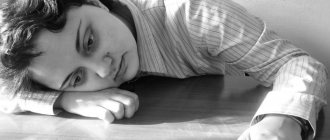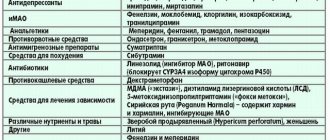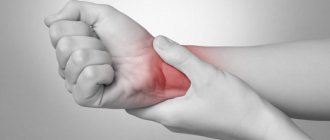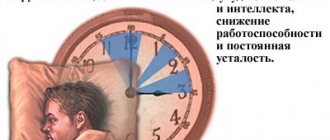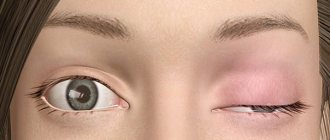Vestibulo-atactic syndrome is a complex of clinical symptoms caused by chronic vascular dysfunction in the brain and damage to the vestibular apparatus . This is not an independent nosology, but a secondary manifestation of major serious diseases, mainly neurological. The main cause of the syndrome is poor circulation in the vertebrobasilar system. The term “ataxia” refers to a disorder of motor skills—movement, speech, and breathing.
In the modern world, the syndrome is quite common. In patients with impaired cerebral circulation, movement disorders manifest: they lose balance when walking and fall out of the blue, unsteadiness of gait and incoordination of movements occur. Such phenomena are associated with damage to nerve structures. The condition of the muscles does not matter.
Treatment of the pathology is complex and comprehensive, including drug therapy, surgery, physiotherapy, and traditional medicine.
Causes
Vestibulo-atactic syndrome is a manifestation of a number of pathological processes. The most common among them are:
- Traumatic brain injury,
- Cerebrovascular accident,
- Cerebral palsy,
- Hydrocephalus,
- Hypertension,
- Atherosclerotic lesion of large cerebral arteries,
- Malignant or benign neoplasms in the brain,
- Autoimmune diseases - multiple sclerosis,
- Extracerebral tumors
- Brain cell atrophy
- Severe intoxication,
- Brain hemorrhages
- Infections,
- Intrauterine developmental disorder of the skull,
- Hepatitis,
- Avitaminosis,
- Ear diseases,
- Vestibular neuritis,
- Labyrinthitis, labyrinthine infarction,
- Meniere's disease,
- Basilar migraine,
- Cervical osteochondrosis,
- Psychogenic disorders,
- Cardiopsychoneurosis,
- Encephalitis.
Most often, vestibulo-ataxic syndrome occurs in patients with various neurological ailments. Its development can be provoked by anxiety, stress, nervousness, emotional outburst, psycho-emotional exhaustion, and physical fatigue. The first clinical signs of the disease remain mild for a long time. As the pathological process progresses, serious problems with coordination of movements arise.
The vertebrobasilar system unites the vertebral and central arteries of the brain, supplying blood to its stem structures. Discirculatory disorders that occur in the human body under the influence of endogenous or exogenous factors lead to hypoxia and ischemia of brain tissue. The high prevalence of the syndrome and the variety of its clinical forms are due to the high sensitivity of stem formations to oxygen starvation. Oxygen deficiency is the cause of disruption of the energy supply to nerve cells and the interaction of the brain with other parts of the central nervous system. When there is insufficient oxygen supply through the bloodstream to the brain, nerve cells die. The toxic effects of certain substances enhance this process. Functional disorders occur in various parts of the brain.
Persons most susceptible to developing the syndrome:
- Those who suffered a skull injury during childbirth,
- Having suffered acute infectious diseases,
- Those exposed to radiation
- Having bad habits
- Neglecting proper nutrition with sufficient amounts of vitamins and microelements in the diet,
- With a genetic predisposition,
- Elderly people with age-related disorders in the functioning of the vestibular apparatus.
Vestibulo-ataxic syndrome is a serious illness that requires urgent medical attention. Only timely diagnosis and proper treatment will increase patients’ chances of recovery. Otherwise, the pathology can lead to disability and even death.
Symptoms
The symptoms of the pathology depend on its root cause, the age of the patient and the general condition of the body.
The first clinical manifestations of motor and vestibular disorders in vestibulo-ataxic syndrome:
- Dizziness,
- Cephalgia,
- Flashing "flies" before the eyes,
- Weakness in the legs
- Nausea and vomiting.
These initial signs of the syndrome are nonspecific and often subtle. Most truly sick people simply do not notice them, mistaking them for a banal ailment. If the disease is not identified and treated in time, it will progress.
Symptoms of a later period of the disease:
- Unstable body position
- Unsteadiness of gait,
- Loss of coordination of movements,
- Dark circles before the eyes, decreased visual acuity,
- Loss of balance
- Falls,
- Eyelid twitching
- Sleep disturbance,
- Chronic fatigue, loss of strength,
- Congestion and noise in the ears.
In children, vestibulo-atactic syndrome is manifested by an uncertain gait, imprecise movements, tremor, and speech disorders. Symptoms of general asthenia often occur, especially in severe cases: shortness of breath, rapid heartbeat, pressure fluctuations, pale skin, drowsiness, depression, irregular breathing and pulse rhythms, changes in body temperature, disorientation in time and space, decreased muscle tone, anxiety, restlessness, panic, fear, profuse sweating, impaired concentration.
There are three stages of development of ataxic pathology, each of which is characterized by a specific set of symptoms:
- Mild stage – mild changes in gait and slight incoordination of movements. Due to the lack of specific and pronounced symptoms, the syndrome is extremely rarely diagnosed at this stage.
- Moderate stage - the patient not only staggers, he is thrown from side to side, problems with coordination of movements become pronounced, cephalalgia, nausea, and dizziness occur.
- Severe stage - patients have difficulty moving and cannot hold the body in one position or another, often fall. It is difficult for them to make even the simplest movements. The changes that occur in the brain of patients at this stage are irreversible. All patients are assigned a disability.
A favorable outcome of the pathology depends on how quickly and correctly the doctor determines the stage of the syndrome and prescribes appropriate treatment.
Separately, there is cephalgic vestibulo-atactic syndrome, the main manifestation of which is unbearable headache. It brings discomfort to a person’s life, disrupts appetite and sleep, and reduces performance. This syndrome is a manifestation of serious diseases of the central nervous system of infectious, inflammatory, oncological or vascular origin. The main goal of doctors is to relieve the patient from painful headaches and eliminate the cause that caused it. To protect yourself from irreversible neuropsychic processes in the future, you should take the appearance of headaches in the present seriously.
Complications of advanced forms of vestibulo-atactic syndrome:
- fall injuries,
- spasms of cerebral vessels,
- development of cephalgic syndrome with constant headache,
- paralysis,
- stroke,
- death.
Video: example of a patient with cerebellar ataxia
How does vestibuloataxia manifest?
An obligatory component of this disorder at the peripheral level is dizziness. It is a consequence of poor functioning of the labyrinth. We have already written that in ICD-10 the syndrome is placed in the section of ear diseases. But in neurological group G there are cerebellar disorders, which can also manifest themselves as vestibuloataxia. Therefore, in addition to dizziness with central disorders, a rather “variegated picture” may arise. The main symptoms of vestibuloatactic syndrome are:
- systemic dizziness . All surrounding objects, the earth, trees, walls of the room rotate in one direction, and the patient can show where exactly;
- nystagmus occurs, horizontally - rotatory , that is, trembling of the eyeballs. During an attack, they move more quickly towards the healthy labyrinth, and return back at a slower pace, towards the sick one;
- imbalance occurs , which is reflected in the patient’s posture and hand movements. In severe cases, a “drunk gait” occurs, in milder cases there is a violation in the Romberg position, when performing the finger-to-toe and heel-to-knee tests;
- autonomic disorders during an attack . They are manifested by nausea, vomiting, deviations in the number of heartbeats and pressure, and body temperature may rise or fall. In some cases, sweating or urination disorders occur;
- In addition to labyrinthine, vestibular symptoms, cochlear disorders often appear , for example, hearing loss, tinnitus on the side of the affected labyrinth.
Quite often, these disorders occur in diseases of the so-called cerebellopontine angle. This is where the vestibulocochlear nerve exits on each side. Most often, the cause is a neuroma, that is, a tumor of the nerve. Therefore, the occurrence of a volumetric process leads to the fact that in addition to the vestibuloatactic syndrome, a cephalgic component arises, that is, a headache appears.
Diagnostics
Since vestibulo-ataxic syndrome has many causes, its diagnosis is quite complex. It consists of conducting a comprehensive examination of the patient and is aimed at identifying the main cause of the syndrome and existing concomitant diseases.
Diagnostic measures include:
- Listening to complaints
- Anamnesis collection,
- Determination of neurological status,
- Carrying out functional tests - Romberg, finger-nose, knee-heel,
- General examination of the patient,
- Testing,
- Lab tests,
- Instrumental methods.
Laboratory diagnostics - hemogram, blood biochemistry, urine tests, cerebrospinal fluid examination.
Instrumental methods to confirm the suspected diagnosis include:
- Tomography is a method for identifying tumors in the brain,
- Encephalography - determination of electrical potentials of the brain,
- Rheoencephalography - assessment of cerebral circulation,
- Duplex ultrasound scanning,
- X-ray of the skull and spine.
To carry out differential diagnosis and exclude other pathologies that can provoke dizziness and loss of balance, nuclear magnetic resonance and Doppleroscopy of brain vessels are used. A CT scan of the brain is performed to exclude other damage to the main structures, and vestibulometry is performed to assess the condition of the vestibular analyzer.
Diagnosis of vestibulo-atactic syndrome
Only a specialist can prescribe treatment for vestibular ataxia after the patient has undergone a comprehensive diagnosis, including various examinations of the body. As a rule, all procedures are aimed both at making a diagnosis of vestibular disorder and at identifying the cause of the syndrome itself - concomitant diseases. To make a correct diagnosis, differential diagnosis is used, which, in addition to a neurological examination of the patient and history taking, includes laboratory research methods:
- general urine analysis;
- cerebrospinal fluid biopsy;
- blood test for biochemistry.
A more clear picture of the disease is provided by instrumental diagnostics, which consists of:
- electroencephalography, to determine the bioelectrical activity of the brain;
- Ultrasound examination of the spine to exclude concomitant diseases of vasoconstriction;
- computed tomography and magnetic resonance imaging, which help detect a tumor in the brain;
- rheoencephalography, which can be used to assess blood circulation and the condition of blood vessels;
- echoencephalography, which helps determine the state of the cerebrospinal fluid, as well as detect hematomas, tumors or abscesses of the brain;
- X-rays of the spine and skull are performed using a special device that emits radiation rays.
A specialist can obtain additional information about the disease by using the following rapid tests:
- Finger test. During this procedure, the patient is asked to close his eyes and alternately reach the tip of his nose with the index fingers of his right and left hands. The presence of the disease is determined by an inaccurate hit, tremor (shaking).
- Romberg's test. Used to assess static ataxia and cerebellar function. The patient needs to stretch his arms forward, fingers apart, legs together. Next he needs to close his eyes. If the patient loses his balance and begins to stagger, this indicates disturbances in the functioning of the cerebellum.
- Knee-heel test. During the procedure, the patient needs to lift one leg from a lying position and touch the knee of the other, then lower it, running the heel along the shin of the other leg. Damage to the part of the brain responsible for balance and coordination causes certain difficulties in performing this task.
- How to unlock an iPhone if you forgot your password
- How and with what to treat gastritis of the stomach
- Barley soup: recipes
Treatment
Treatment of vestibulo-atactic syndrome is complex and multi-stage. It is prescribed by a neurologist or neuropathologist based on the results of a diagnostic examination. They recommend that all patients lead a healthy lifestyle, following the principles of proper nutrition and completely eliminating bad habits. Mild vestibulo-atactic syndrome in children does not require treatment. As the child grows older, the disease goes away on its own.
Patients should eat properly, excluding spicy, fatty, spicy, smoked and salty foods, strong tea and coffee, and alcohol from the diet. The daily menu should be enriched with natural juices and foods containing vitamins and microelements. Patients are recommended to eat vegetable soups and salads, fermented milk products, cereals and whole grain bread.
Drug therapy is aimed at normalizing the general well-being of patients and eliminating the main clinical manifestations. Since the causes of the syndrome are not precisely determined, the effectiveness of such treatment is very relative.
Patients are prescribed:
- Statins to combat atherosclerosis - Atoris, Rosuvastatin,
- Hypotonics to lower blood pressure - “Capoten”, “Lisinopril”,
- Antioxidants – “Actovegin”, “Mildronat”, “Mexidol”,
- Vascular drugs - Cavinton, Trental, Vinpocetine,
- Sedatives – “Valerian extract”, “Novopassit”, “Persen”,
- Antidepressants - Prozac, Amitriptyline,
- Sensitizing drugs – “Diphenhydramine”, “Suprastin”,
- Medicines with vasodilating, antiplatelet and neurometabolic effects - “Betaserc”, “Betaver”,
- Steroids – Prednisolone, Dexamethasone,
- Vitamins A, E, B, PP and vitamin-mineral complexes.
Outpatient treatment is indicated for patients with mild to moderate forms of pathology. Patients with an advanced stage of the disease are hospitalized, in the presence of severe complications or their inability to move independently.
If such therapy does not produce positive results, and the patient's condition continues to deteriorate, doctors prescribe intravenous corticosteroids and plasma exchange therapy. In some cases, the only salvation for patients is surgery, the effectiveness of which usually reaches 70%.
Physiotherapy complementary to drug treatment:
- medicinal baths,
- massage,
- exercise therapy,
- oxygen therapy,
- acupuncture,
- hypnosis,
- Ural Federal District,
- reflexology,
- magnetic laser influence.
Special physical exercises increase the resistance of the vestibular apparatus. They normalize coordination of movements, increase the threshold of excitation, and restore the stability of a person’s vertical posture.
Traditional medicine complements, but does not replace, drug therapy. They can only be used after consultation with a specialist. The most common folk recipes intended to treat the syndrome:
- infusion of corn silk or juniper berries,
- remedy of garlic, honey and lemon,
- a decoction of thyme, motherwort, mint and borage,
- spring primrose flower tea,
- remedy of cranberry, honey and horseradish,
- mint infusion.
These general therapeutic measures restore the functioning of the statokinetic analyzer and eliminate dizziness. Patients become more confident in their gait, the functioning of the nervous system improves, and anxiety, restlessness, and panic disappear. The structures of the vestibular apparatus begin to work fully, the general resistance of the body increases, pain and discomfort disappear, the severity of dizziness and dyspepsia decreases, heart rate and blood pressure levels normalize. The patients' movements become coordinated and their body position becomes stable. The body's condition noticeably improves, performance is restored, and the quality of life increases.
Prevention
Medical recommendations to prevent the development of the syndrome:
- Balanced and rational nutrition,
- Maintaining a daily routine
- Performing physical exercises that train coordination and the vestibular system,
- Rejection of bad habits,
- Maintaining a healthy lifestyle,
- Adequate sleep and rest,
- Prevention of stress,
- Strengthening immunity,
- Fighting obesity
- Limited sun exposure
- Psycho-emotional calm,
- Compliance with medical prescriptions in the presence of concomitant diseases.
Causes of vestibular ataxia
Depending on the levels of damage, two types of disorders are distinguished:
- peripheral disorders . In this case, there are diseases of the middle ear, vestibular apparatus (semicircular canals), and there may also be damage to the first neuron, which lies in the vestibular ganglion, for example, with ganglionitis.
- central lesions . In this case, the brain pathways are affected. These lesions are cortical, nuclear, supranuclear and intermediate.
Quite often, symptoms of vestibuloatactic disorders can also be caused by disorders of the cerebellum, which is closely connected with the vestibular analyzer by bilateral connections.
Forecast
Any disease, including vestibulo-ataxic syndrome, should be treated in the early stages, when the risk of developing irreversible changes is minimal. If the syndrome is started, the body will not survive. When the first symptoms of pathology appear, you should consult a specialist for medical help. For the therapy to be effective, it is necessary to determine the cause of the disease. It is necessary to treat not the symptoms, but to eliminate all etiopathogenetic factors that provoked the disease.
The prognosis of vestibulo-atactic syndrome is favorable if the patient consults a doctor in time and begins treatment. Elderly people and people with an advanced stage of the syndrome have irreversible changes in the body that cannot be treated. The disease progresses steadily and leads to serious consequences.


